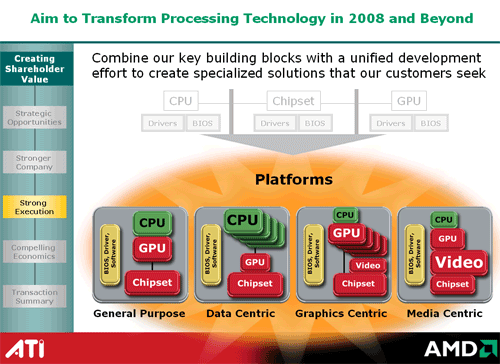AMD and ATI Merger: Our Questions Answered
Rumors have been circulating for weeks, but yesterday the two companies involved made it official. AMD and ATI announced that the two companies planned to merge in a deal worth approximately $5.4 billion dollars. The quote below from the initial press release reveals some of the combined entity's vision of the future...
| "On July 24, 2006, AMD and ATI announced a plan to join forces, in a transaction that will combine AMD's technology leadership in microprocessors with ATI's strengths in graphics, chipsets and consumer electronics. The result is a processing powerhouse: a new competitor, better equipped to drive growth, innovation and choice for its customers in commercial and mobile computing segments and in rapidly-growing consumer electronics segments. The transaction, valued at US $5.4 billion, is expected to close in Q4 2006 subject to approval by ATI shareholders, court approval, regulatory approvals and other customary closing conditions." |
Some more details are available on AMD's website, right here. Not content with the general information available on-line, we fired off some questions to AMD to get a little more detail on the company's future plans and how they feel the merger will impact the Computing Market and consumers in general. Our questions and AMD's answers are posted below and on the proceeding pages.
Considering the enormity of this news, and the potential impact it could have on a number of major companies in the technology industry, we also thought we'd get some opinions from Intel and NVIDIA regarding the proposed AMD / ATI merger as well. For now, all Intel had to say was,"We will study the transaction, but have no comment at this time about any possible impact it might have on our agreements with ATI." Clearly this merger is a move AMD considered necessary to remain competitive with Intel moving forward, but Intel isn't quite ready to give an in-depth opinion on the matter. We're sure that will come in time.
NVIDIA on the other hand had a little more to say. A representative from NVIDIA said, "Today's news about the acquisition of ATI by AMD is a positive development for NVIDIA. We are now the only graphics processor and core logic company that supports both Intel and AMD processors. We will continue to execute on our strategy, which is to develop industry-changing GPU and platform technologies, extend the use of the GPU into new applications, and expand its reach into all computing devices - from PCs to servers to phones." We've also sent a few direct questions over to NVIDIA and hope to have some more detailed responses on-line soon.
Our questions to AMD are italicized and the company's exact response, courtesy of Jon Carvill, immediately follows.
HotHardware: AMD has publicly made statements in the past regarding the importance of the co-processor and the importance of it to your overall strategy. Can we expect a tighter coupling of the GPU with the CPU in future AMD architectures?
AMD / ATI: In June at our analyst day in Sunnyvale, AMD introduced "Torrenza" and reinforced our commitment to an open architecture for third-party innovation. In the near term, 2007, we should be able to deliver new customer-centric, unified solutions for key market segments like mobile and commercial. For these market segments a tighter coupling of the CPU and GPU has the potential to deliver a compelling performance-per-watt proposition.

HotHardware: What sort of fab efficiencies can be realized in the acquisition of ATI, for either GPU or Core Logic chipsets? Is there a near term and long term strategy that you can discuss?
AMD / ATI: ATI will continue to manufacture its graphics processors with TSMC and UMC for the foreseeable future. AMD is very comfortable with a hybrid approach to manufacturing as evidenced by our recent success in ramping microprocessor production at Chartered Semiconductor.








